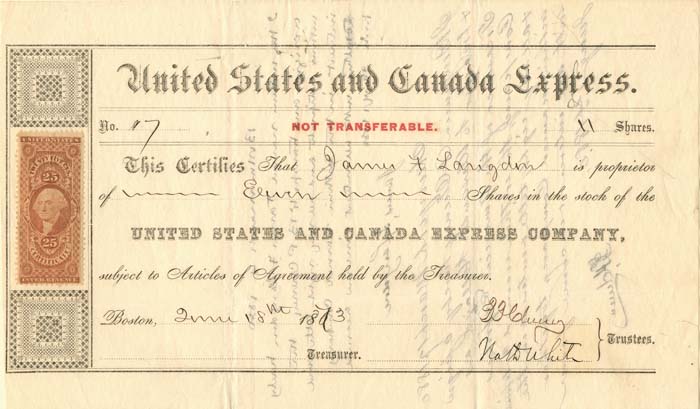United States and Canada Express signed by B.P. Cheney
Inv# AG1568 Stock
Stock signed twice by Benjamin Pierce Cheney (August 12, 1815 – July 23, 1895) was an American businessman, and a founder of the firm that became American Express. Cheney was born in Hillsborough, New Hampshire to Jesse and Alice (Steele) Cheney. The family were descended from John Cheney, who was recorded in Roxbury, Massachusetts, in 1635, moving the following year to Newbury, Massachusetts. John Cheney's brother, William, recorded in Roxbury by 1640, was an ancestor of former Vice President Dick Cheney. He was also evidently kin to the Benjamin Cheney or Cheany of Hartford, Connecticut, from whom John Fitch, the inventor of the steamboat, learned the trade of clocksmith in 1760. Cheney's father was a blacksmith, and he began working in his father's shop at age 10. At age 12 he began working at a tavern and later a general store in Francestown, New Hampshire. In 1831 he started work as a stagecoach driver between Nashua and Exeter, soon moving to the route between Nashua and Keene. The stage did a brisk business due to the dearth of rail lines at the time. Cheney built relationships with some of his passengers at this time, including Daniel Webster, whose friendship lasted the rest of his life. With a reputation for honesty and reliability, he was frequently entrusted with large sums of money destined for banks on his route. In 1836 he became a stage agent in Boston. Cheney joined Nathaniel White and William Walker in 1842 to organize an express line between Boston and Montreal. In 1852 Cheney effected his first consolidation when he bought out Fisk & Rice's Express between Boston and Burlington, Vermont. Subsequent consolidations resulted in the organization of the United States & Canada Express Company in 1854. In 1854, while on his way home from Canada, he lost his right arm in a railway accident. Cheney was elected a director of Wells Fargo & Company in September 1854 in place of Alpheus Reynolds, who had resigned. He retired from the Wells Fargo board in 1877, but again served as a director from 1882 to the beginning of 1884. Cheney sold United States & Canada Express in 1879 to American Express, at which time he became the company's largest shareholder as well as treasurer and a director. He remained a large shareholder of Wells Fargo, National Express, and others. Through his business contacts, Cheney became interested in the Vermont Central Railroad (later the Central Vermont), the Northern Pacific Railroad, the Atchison, Topeka and Santa Fe Railroad, and the San Diego Land and Town Company. He was also the founder and a director of the Market National Bank of Boston and the American Loan and Trust Company. He helped finance the Northern Pacific and the Atchison, Topeka and Santa Fe, and had much to do with geeting Wells Fargo's express service on both roads. He was a director of the Santa Fe from 1873 to 1894. When it became evident the railroad was in dire straits, other directors sold their shares. Cheney refused to take advantage of his inside information and held his shares, suffering a significant personal loss when the railroad went bankrupt in the Panic of 1893 and was reorganized.
Rare and Important! Portrait and biography included.
A stock certificate is issued by businesses, usually companies. A stock is part of the permanent finance of a business. Normally, they are never repaid, and the investor can recover his/her money only by selling to another investor. Most stocks, or also called shares, earn dividends, at the business's discretion, depending on how well it has traded. A stockholder or shareholder is a part-owner of the business that issued the stock certificates.










Ebay ID: labarre_galleries